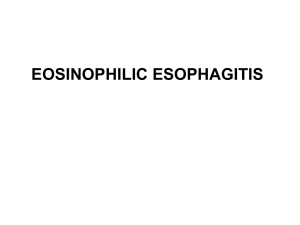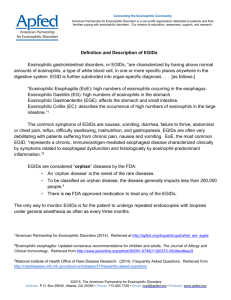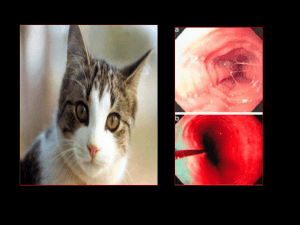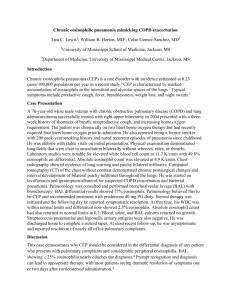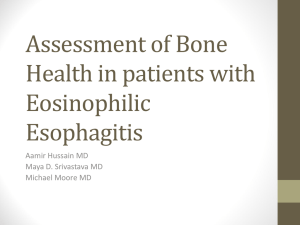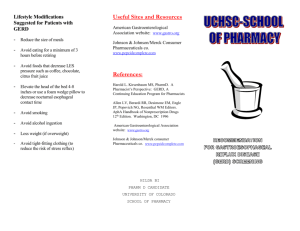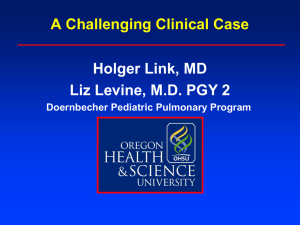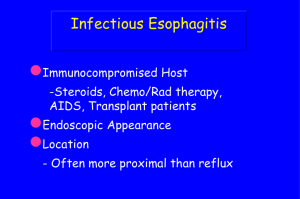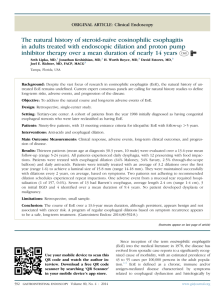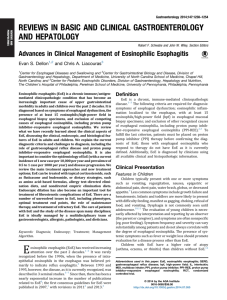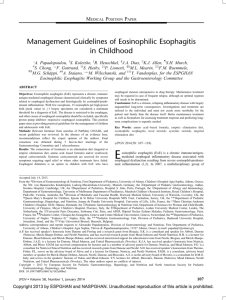Eosinophilic Esophagitis
advertisement
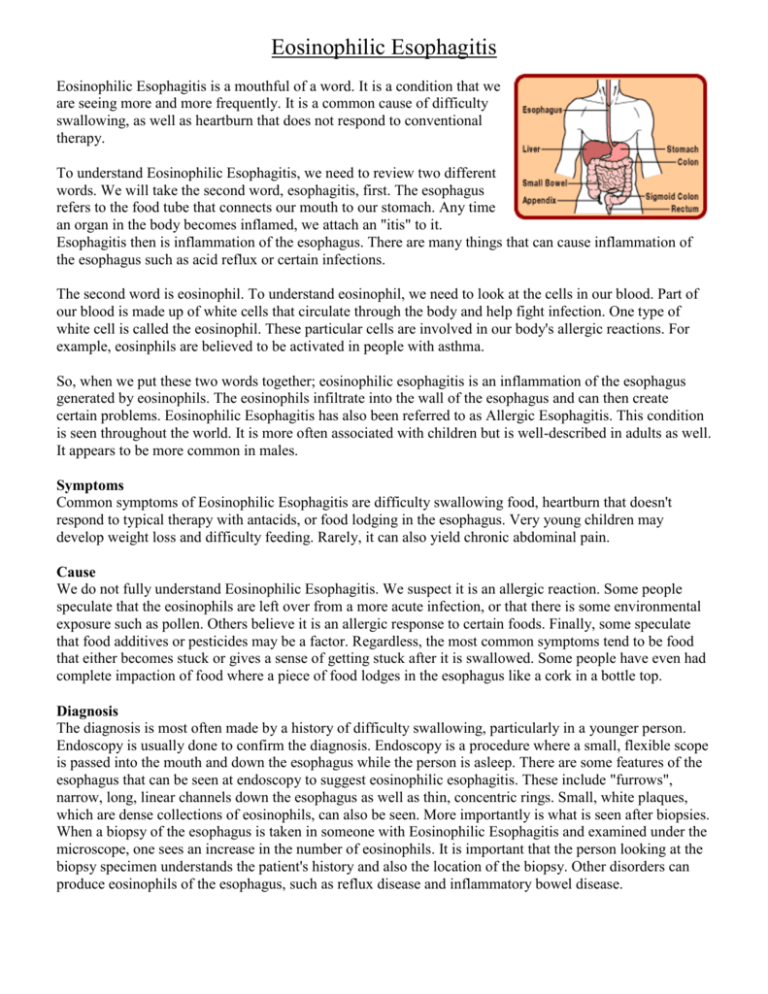
Eosinophilic Esophagitis Eosinophilic Esophagitis is a mouthful of a word. It is a condition that we are seeing more and more frequently. It is a common cause of difficulty swallowing, as well as heartburn that does not respond to conventional therapy. To understand Eosinophilic Esophagitis, we need to review two different words. We will take the second word, esophagitis, first. The esophagus refers to the food tube that connects our mouth to our stomach. Any time an organ in the body becomes inflamed, we attach an "itis" to it. Esophagitis then is inflammation of the esophagus. There are many things that can cause inflammation of the esophagus such as acid reflux or certain infections. The second word is eosinophil. To understand eosinophil, we need to look at the cells in our blood. Part of our blood is made up of white cells that circulate through the body and help fight infection. One type of white cell is called the eosinophil. These particular cells are involved in our body's allergic reactions. For example, eosinphils are believed to be activated in people with asthma. So, when we put these two words together; eosinophilic esophagitis is an inflammation of the esophagus generated by eosinophils. The eosinophils infiltrate into the wall of the esophagus and can then create certain problems. Eosinophilic Esophagitis has also been referred to as Allergic Esophagitis. This condition is seen throughout the world. It is more often associated with children but is well-described in adults as well. It appears to be more common in males. Symptoms Common symptoms of Eosinophilic Esophagitis are difficulty swallowing food, heartburn that doesn't respond to typical therapy with antacids, or food lodging in the esophagus. Very young children may develop weight loss and difficulty feeding. Rarely, it can also yield chronic abdominal pain. Cause We do not fully understand Eosinophilic Esophagitis. We suspect it is an allergic reaction. Some people speculate that the eosinophils are left over from a more acute infection, or that there is some environmental exposure such as pollen. Others believe it is an allergic response to certain foods. Finally, some speculate that food additives or pesticides may be a factor. Regardless, the most common symptoms tend to be food that either becomes stuck or gives a sense of getting stuck after it is swallowed. Some people have even had complete impaction of food where a piece of food lodges in the esophagus like a cork in a bottle top. Diagnosis The diagnosis is most often made by a history of difficulty swallowing, particularly in a younger person. Endoscopy is usually done to confirm the diagnosis. Endoscopy is a procedure where a small, flexible scope is passed into the mouth and down the esophagus while the person is asleep. There are some features of the esophagus that can be seen at endoscopy to suggest eosinophilic esophagitis. These include "furrows", narrow, long, linear channels down the esophagus as well as thin, concentric rings. Small, white plaques, which are dense collections of eosinophils, can also be seen. More importantly is what is seen after biopsies. When a biopsy of the esophagus is taken in someone with Eosinophilic Esophagitis and examined under the microscope, one sees an increase in the number of eosinophils. It is important that the person looking at the biopsy specimen understands the patient's history and also the location of the biopsy. Other disorders can produce eosinophils of the esophagus, such as reflux disease and inflammatory bowel disease. Treatment There is still much to learn about the best treatment for eosinophilic esophagitis. It is important to find an underlying cause if allergy is suspected. Sometimes, a person will have a known food allergy and this food should be avoided until it is clear if the particular food allergy is associated with the symptoms. Common foods associated with Eosinophilic Esophagitis include egg, milk, soy, wheat and corn. Because of these potential associations, often times these foods are eliminated from the diet and slowly reintroduced to determine if there is a correlation between the food and the symptoms. Allergy testing can also be carried out to help guide diet changes. Acid suppression with any number of medications is often a first line approach. It is not always effective but is generally safe and may help some people. When there is a narrowing in the esophagus, sometimes a dilation is performed. Dilation needs to be done particularly carefully as the esophagus can become quite stiff and narrow. Because of this, there is a risk of tearing or perforating the esophagus. When people do not respond to diet changes or acid suppression, sometimes steroids are used. Fluticasone (Flovent) is an inhaled steroid that is used in asthma. It can be used for patients with Eosinophilic Esophagitis. Instead of inhaling the steroid, however, the steroid is swallowed with a small amount of water. Oral steroids, such as prednisone, have also been found to be effective but the risk and benefits of this approach need to be weighed individually and discussed with your physician. Summary There is so much to learn about eosinophilic esophagitis, but it appears to be increasing in incidence and is a common cause for people, young and old, with difficulty swallowing food. The symptoms may be controlled with either acid suppression or identifing a triggering food group. Endoscopy is often used to diagnose the disorder based on the number of eosinophils on biopsy but can also be used to follow a response to treatment. Elimination diets can be effective but referral to an allergist is often helpful to guide the diet changes. Finally, topically applied steroids in the form of swallowed Fluticasone have been shown to be effective in some patients. This packet was prepared for you by Dr. Aaron J. Burrows (303) 320-1111
